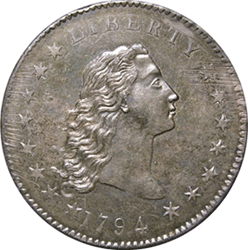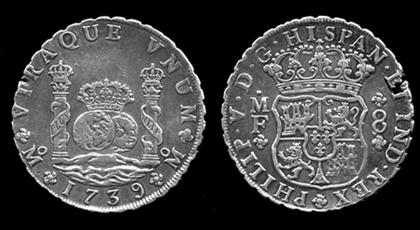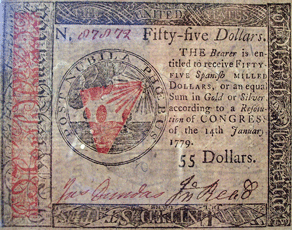|
Flowing Hair Dollar, the $10 Million Coin
Answer
to Name
This Famous Antique Game - April 2014
By Mike McLeod
|
 |
|
Sherry Blanton, Ted Carlton of Utah and Sherron Lawson of Roswell, Ga., correctly identified the coin that was sold for $10,016,875 (including buyer’s premium), the highest price paid thus far.
The 1794 Flowing Hair dollar was the first minted by the United States Government. It was engraved by Robert Scot to represent Liberty, as the title above her head so says. The coin’s face bears 15 stars representing the 15 states in the Union at that time. All 1,758 of the coins minted were struck on Oct. 15, 1794, and about 135 still exist today.
So why was this particular coin so valuable? Aside from it being the first silver coin series minted, it was uncirculated, and it shows no die imperfections as its sisters do, meaning this coin was struck early, if not first. The scratch marks and silver plug (the darker spot under the ear) are signs of weight adjustments to meet the U.S. Mint’s specifications, which are also signs this coin was early or first in the series.
|

1794 Flowing Hair dollar. (Photo, courtesy of Steve Contursi, president of Rare Coin Wholesalers, www.rarecoinwholesalers.com.)
|
In addition, there is the possibility that it may have been touched by George Washington or other Founding Fathers since it was one of the first U.S. dollars minted. Steven Contursi of Rare Coin Wholesalers purchased the coin in 2003 for $2.5 million, and he is credited with determining its rarity. He sold it in 2010 for $7.85 million to Cardinal Collection Education Foundation. Then in early 2013, Cardinal had the coin auctioned, and Legend Numismatics of New Jersey purchased it and its history for more than $10 million.
Although Congress passed a law in 1792 authorizing the minting of coins, silver coins were not produced until 1794. The reason for the delay was the law required the U.S. Mint’s chief coiner and assayer to each post a bond of $10,000 before they minted gold or silver coins—just in case they decided to abscond with the precious metals in their care. In our terms, this was asking them to come up with more than $200,000 each. Neither man could afford this so only copper coins were produced for the first two years until Congress lowered their bond requirements to $5,000 and $1,000, respectively.1
What did citizens of the new United States use for currency until 1794? The Spanish silver dollar, or peso de ocho (piece of eight), was actually the world’s reserve currency at the time, and it was commonly used in the States. In addition, Continental currency, or “continentals,” was issued by the Continental Congress and used until about 1781 when it was all but worthless. (Continentals were not backed with gold or any other valuable asset. Also, the British government counterfeited them in vast amounts.) The individual states also printed their own currencies, and individuals used trade goods or even wampum for money.
|

|

|
|
The Spanish dollar (eight real coin or piece of eight)
was used as currency in the U.S. until 1857.
|
A $55 continental note, printed in red and black and exchangeable for “55 Spanish Milled dollars,” it says. By 1780, it was only worth about one-fortieth of its face value.
|
Wampum (shells on strings) used by the Eastern Tribes also succumbed to deflation in value to almost nil as European traders “minted” their own wampum in record amounts. They had access to more beaches in their homelands and around the world to scour for this type of money.
terms shelling out, meaning to pay, and clams, meaning dollars, came from wampum, the shell money.2
---------------------------------------
1 www.coincommunity.com.
2 http://szabo.best.vwh.net/shell.html.
|